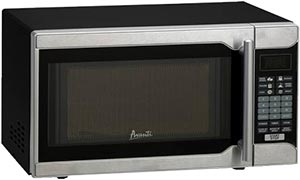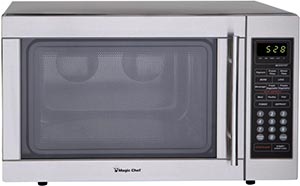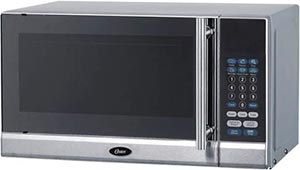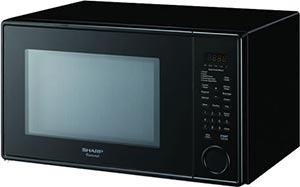Many people
use their microwaves every day without giving a second thought to the maintenance they should be performing or the damage they might be causing. Unfortunately, the way you use and care for your microwave can have a significant effect on its longevity.
The good news is that a few good habits can make a substantial difference. On average, microwaves typically last between 5-10 years, and you can expect a similar — or even better — lifespan from yours if you start doing the following things.
1. Keep It Clean
One of the easiest ways to extend the longevity of your microwave is by cleaning it regularly. Many people do not realize that food and liquid spatters can absorb energy, leading to burn spots and even causing damage to components of the microwave. Most foods and liquids can be removed with warm soap and water or a specialized microwave oven cleaner.
For stubborn spots, you can try heating a cup of water in the microwave for 60 to 90 seconds; the steam should help loosen the grime. You can also easily prevent most microwave messes by purchasing a microwave cover or simply using materials such as paper towels or wax paper to cover your dishes during the heating process.
2. Choose Dishware Carefully
Materials that are not microwave safe can cause fires or explosions, so for the sake of safety and the longevity of your microwave, you should only use microwave-safe dishware. You should never put the following items into a microwave:
- Aluminum foil
- Metal
- Dishware with silver or gold accents
Typically, ceramic, glass, and plastic items are safe to microwave, but there are exceptions. Instead of making assumptions, look for the microwave-safe label on a piece of dishware. If there is no label, you can conduct a simple test to determine whether a dish or container is microwave safe. Put the item in the microwave, along with a microwave-safe cup or bowl containing water, and heat everything for one minute. If the container or dish is extremely hot, it has absorbed too much energy and would not be recommended to use in the microwave.
As a final tip, if you are microwaving food and notice that a container or piece of dishware becomes significantly hotter than the food, you should avoid using that item in the future.
3. Prevent Door Damage
Doors are among the most widely abused parts of a microwave. At some point, most people have slammed a microwave door, pushed it shut with an elbow for lack of free hands, or pulled the door open without first turning off the microwave.
All of these actions may cause gradual damage to your unit. Microwave latches are more complex than many people appreciate; some latches have as many as three switching mechanisms that must close in the correct order. Closing the door carelessly may damage these switches. Pulling the door open while the microwave is running, meanwhile, can result in a blown safety fuse.
4. Avoid Running on Empty
Running a microwave without anything inside it can cause serious damage. When a microwave is empty, the energy the microwave produces must be absorbed by its own components, such as the glass or the magnetron that produces the energy. These components are not designed to withstand this kind of exposure, and repairing or replacing them can be expensive. If you like to use your microwave as a timer, most microwaves have separate timer functions that count the time without producing any internal energy.
5. Try Preprogrammed Cooking Times
Many people use preprogrammed microwave cooking times rarely, if ever. However, these times are designed to make the most efficient use of the microwave, by minimizing energy loss and heating the food as effectively as possible. Give these preset cooking modes a try, and you may find that your food not only comes out better, but you’ll also help prevent some of the other issues that can cause microwave damage, such as messes that lead to burn spots.
6. Respect Weight Limitations
In most cases, there is no need to worry about the weight capacity of a microwave, since many foods and dishes are well below this capacity. However, if you are microwaving heavier dishes or large frozen items, make sure to check the weight capacity of your unit. It is usually printed on the microwave door; if not, the information should be available online or in the owner’s manual. An item that is excessively heavy can mechanically strain the turntable and its motor, along with central components such as the magnetron. All of this can lead to a damaged unit and food that isn’t properly cooked.
7. Guard Against Surges
Power surges can be caused by all kinds of events, including lightning, downed power lines, and grid switching. Unfortunately, out of all the
appliances in the kitchen these surges can be especially damaging to microwaves. You can unplug your microwave oven between uses if you want to save energy, or you can simply plug it into a surge protector. A surge protector is the most convenient solution for most homeowners, since you will not have to worry about a forgetful moment that eventually leads to your microwave becoming damaged.
8. Keep Up With Easy Replacements
Basic maintenance reduces wear and strain on your microwave oven, and there are many forms of maintenance that you should be able to perform independently. Replacing parts such as light bulbs, door latches, turntables, turntable motors, and charcoal filters is safe and affordable. Most of these problems should be relatively easy to diagnose, too. The charcoal filter is one of the only simple parts that can be easy to forget about. If your filter appears greasy or if your microwave vents strange odors, this usually indicates that grease has built up and a new filter is needed.
9. Know When to Call for Help
It is important to remember that microwave ovens use complex electrical systems and store large amounts of power. The capacitor in a microwave oven may even maintain a large charge after the microwave has been unplugged. This means that you should never try to repair any electrical microwave parts on your own — you may cause additional damage or seriously hurt yourself. Instead, call a professional to inquire whether it would be worth repairing or just replacing the unit.
Enjoy Years of Use
These tasks and habits are all simple and affordable, but they can make a huge difference over time. If you make a small effort to use your microwave properly and maintain it well, you can expect that effort to pay off noticeably for several years.
Learn More:
 All termite damage can be repaired, all termite infestations can be controlled.
All termite damage can be repaired, all termite infestations can be controlled. All termite damage can be repaired, all termite infestations can be controlled.
All termite damage can be repaired, all termite infestations can be controlled.








